Sisyrinchium angustifolium: Blue-Eyed Grass
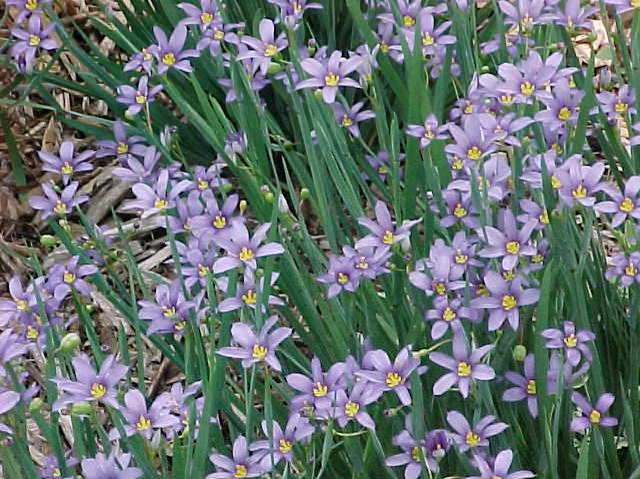 Latin name: Sisyrinchium angustifolium
Latin name: Sisyrinchium angustifolium
Common name: Blue-eyed grass
Flowers: Blue showy flowers 16
Fruit: Inconspicuous 16
Height & Width: 2’ x 1’ 12
Type: Perennial 16
Habit: Forb/herb 16
Wetland indicator category**: FACU FACW- 17
Texture: Fine 16
Growth rate: Moderate 16
Light: Full sun 12
Moisture: Medium 12
Soil*: Fine and medium, ph 5-7 16
Zones: 4-9 12
Origin: Eastern half of United States 16
Features: Although they appear to be grasses and are called as such, Sisyrinchium is actually a member of the iris family. Violet-blue flowers appear at the top of branched stems that grow up through the grass-like foliage. Typically this perennial forms in clumps together. 12
Siting: These plants perform well in medium moisture and well-drained soils. They prefer full sun, but the soil must remain moist. Typically they are found growing in damp forests. 12
Care: Plant crown at soil level 18. At planting, water the roots and surrounding area slowly and deeply. Keep soil moist until plant is established, then apply enough water to thoroughly moisten the root zone when the soil is dry or during drought. Modify water recommendations to reflect site drainage and rainfall. Apply 3” of mulch over the planted area. Do not allow mulch to touch the plant stems. 18
Pests: Plants are relatively pest resistant if cultural preferences are met.
Author: Alexander Smolka
Sources 1-18 found on Sources page
Latin name: Sisyrinchium angustifolium
Common name: Blue-Eyed Grass
Flowers: Several blue, deep blue-violet flowers with yellow centers in 2 broad bracts 10. Half inch flowers bloom from March to June on stalks above the leaves 13
Fruit or cones: Less than 1-inch, non-showy brown fruit display from May to July 13
Height & Width: Height of 1 foot 6 inches - 2 feet with a width of 6 inches - 1 foot 13
Type: Herbaceous perennial 10
Habit: Clumping 13
Wetland indicator category**: FACW, FACU 17
Texture: Medium 13
Growth rate: Medium 13
Light: Full sun, part-shade 10
Moisture: Medium 12
Soil*: Fine and medium, pH in 5-7 range 16
Zones: 4 - 9 Medium 12
Origin: Eastern portion of the United States 16
Ecosystem benefits: Food for birds. Nectar and pollen for butterflies, bumblebees, sweat bees, bee flies, and syrphid flies 13
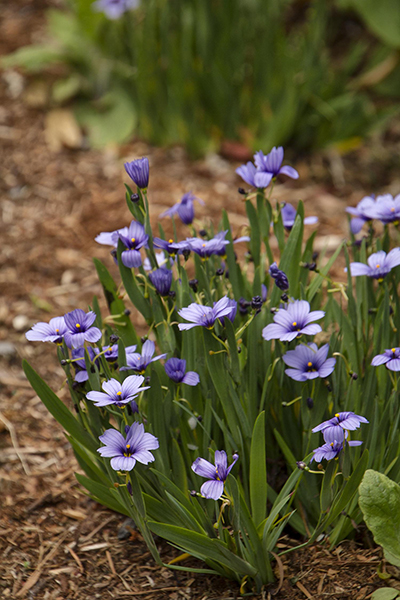
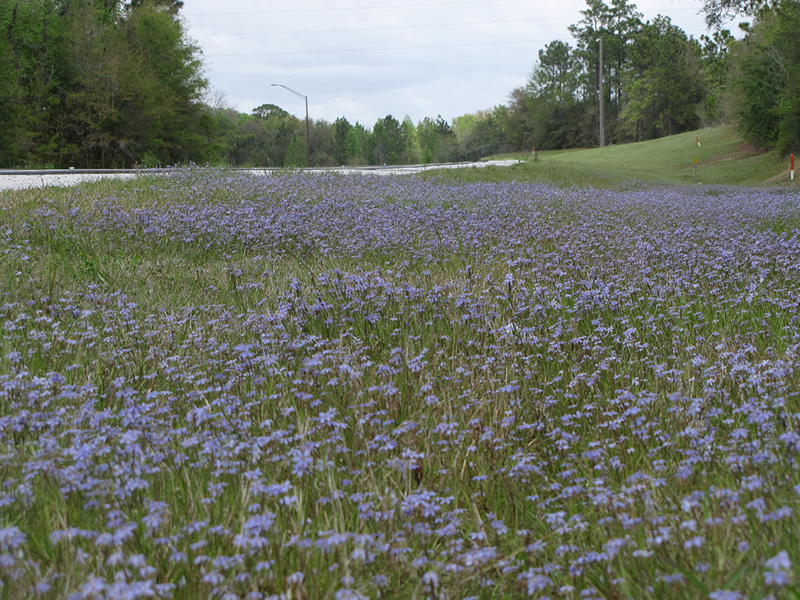
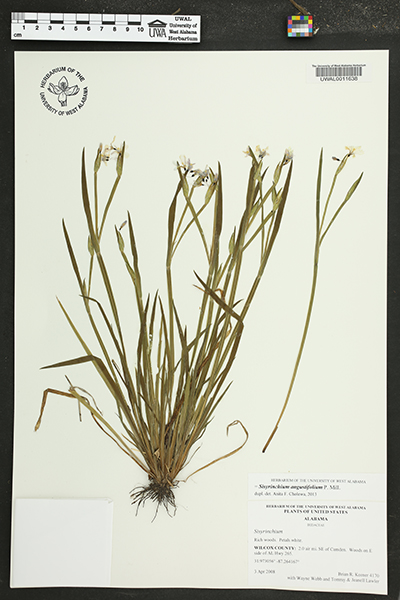
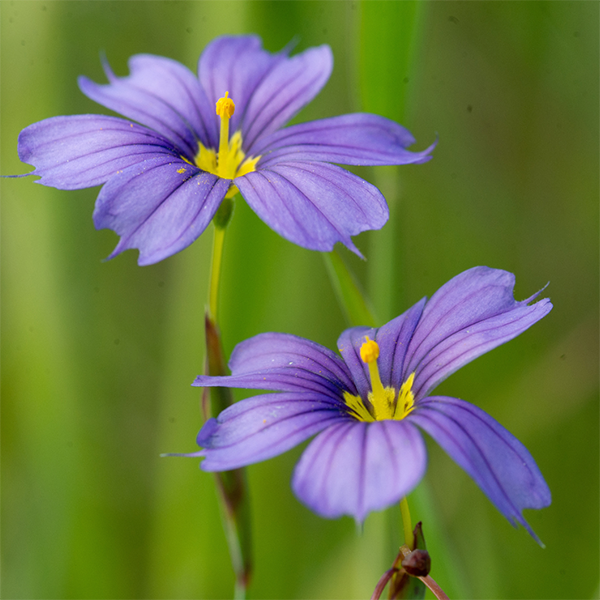
Features: Semi-evergreen ground cover with dense, clumping habit. Slender, sword-shaped leaves form an upright fan shape providing a hint it is in the iris, not grass, family13. Flowers consist of volet-blue tepals that burst out in a star shape from a central, yellow eye12. Grows well in moist locations, including marshes, slopes, and banks, making it a good choice for rain gardens. Attracts a variety of pollinators 13.
Siting: Moist to average soil and prefers moist meadows, marshes, low woods, damp open woods, on stream banks and slopes 13.
Care: Plant crown at soil level 18. At planting, water the roots and surrounding area slowly and deeply. Keep soil moist until plant is established, then apply enough water to thoroughly moisten the root zone when the soil is dry or during drought. Modify water recommendations to reflect site drainage and rainfall. Apply 3” of mulch over the planted area. Do not allow mulch to touch the plant stems. 18.
Pests: Plants are relatively pest resistant if cultural preferences are met 13.
This plant does not appear on the following invasive plant lists on 9/27/22:
USDA SC Invasive Plant Species
SC Exotic Plant Pest Council
Author: Hannah Arborgast
Image source:
1) https://www.pahls.com/wp-content/uploads/2021/03/Perennial_Sisyrinchium-Lucerne-Blue-Eyed-Grass3.jpg
2) http://www.floraofalabama.org/img/specimens/UWAL/UWAL0011638.jpg
3) https://www.flawildflowers.org/wp-content/uploads/2016/04/sisyrinchium_angustifolium_norcini-e1602526807128.jpg
4) https://northerngardener.org/wp-content/uploads/bb-plugin/cache/Untitled-design-11-square.png
Sources:
- Armitage, A. (2001). Armitage’s manual of annuals, biennials, and half-hardy perennials. Portland, OR: Timber Press.
- Armitage, A. (2006). Armitage’s native plants for North American gardens. Portland, Oregon: Timber Press.
- Armitage, A. (2008). Herbaceous perennial plants: A treatise on their identification, culture, and garden attributes. Athens, GA: University of Georgia.
- Clemson Cooperative Extension Home and Garden Information Center.(2011). Flowers fact sheets. Retrieved from http://www.clemson.edu/extension/hgic/plants/landscape/ flowers/
- Clemson Cooperative Extension Home and Garden Information Center.(2011). Groundcovers & vines fact sheets. Retrieved from http://www.clemson.edu/ extension/hgic/plants/landscape/groundcovers/
- Clemson Cooperative Extension Home and Garden Information Center.(2011). Trees. Retrieved from http://www.clemson.edu/extension/hgic/ plants/landscape/trees/
- Clemson Cooperative Extension Home and Garden Information Center.(2011). Shrubs. Retrieved from http://www.clemson.edu/extension/hgic/plants/landscape/shrubs/
- Dirr, M. A. (2009). Manual of woody landscape plants. Champaign, IL: Stipes Publishing.
- Gilman, E. F. (1997). Trees for urban and suburban landscapes. Albany, NY: Delmar Publishers.
- Lady Bird Johnson Wildflower Center University of Texas at Austin. (2012). Native plant information network. Retrieved from http://www.wildflower.org/explore/
- McMillan, P., Plant taxonomist Clemson University, personal communication.
- Missouri Botanical Garden Kemper Center for Home Gardening. Plant finder. Retrieved from http://www.mobot.org/gardeninghelp/plantfinder/Alpha.asp
- North Carolina State University (2005). Plant fact sheets. Retrieved from http://www.ces.ncsu.edu/depts/hort/consumer/factsheets/index.html
- Strother, E. V., Ham, D. L., Gilland, L. (2003) Urban tree species guide: Choosing the right tree for the right place. Columbia, SC: South Carolina Forestry Commission.
- University of Florida, IFAS Extension. (2011). Southern trees fact sheet. Retrieved from http://edis.ifas.ufl.edu/department_envhort-trees
- USDA . Plant profile. (n/d).Retrieved from http://plants.usda.gov/java/
- USDA. Plant wetland indicator status. (n/d). Retrieved from http://plants.usda.gov/wetland.html
- Vincent, E., Environmental horticulturist Clemson University, personal communication.
- Clemson Extension. Carolina Yards Plant Database. Retrieved from https://www.clemson.edu/extension/carolinayards/plant-database/index.htm
*Soil pH is determined using a professional soil test. Contact your Clemson University County Extension service for assistance www.clemson.edu/extension/. Click on “local offices”.
**2012 Plant Wetland Indicator categories (quantitative derived) http://plants.usda.gov/wetinfo.html
| Indicator Code | Indicator Status | Comment |
|---|---|---|
| OBL | Obligate Wetland | Almost always is a hydrophyte, rarely in uplands |
| FACW | Facultative Wetland | Usually is a hydrophyte but occasionally found in uplands |
| FAC | Facultative | Commonly occurs as either a hydrophyte or non-hydrophyte |
| FACU | Facultative Upland | Occasionally is a hydrophyte but usually occurs in uplands |
| UPL | Obligate Upland | Rarely is a hydrophyte, almost always in uplands |
